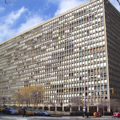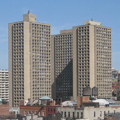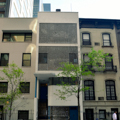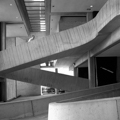The term Brutalism has served as a rallying cry, a stylistic label, and an epithet. The term originated in the early 1950s in England, where the phrase “New Brutalism” was associated with the architectural attitude of a younger generation of architects, particularly Alison and Peter Smithson. In Britain, as the Smithsons argued, this usage related to an ethical stance of a younger generation of architects that sought to align architecture to hard truths about the social reality of postwar Britain. After spreading quickly to the United States, the “new” was dropped and the term Brutalism emerged in the 1960s and 1970s as a style label for a set of late Modernist buildings that emphasized monumental, sculptural forms with surfaces of exposed, often textured concrete, frequently intermingled with exposed brick. In the American context, Brutalism specifically evoked the French phrase béton brut or raw concrete, Le Corbusier’s term for poured-in-place concrete imprinted with the texture of its formwork. Le Corbusier’s expansive use of béton brut in his postwar buildings served as inspiration for many of the Brutalist architects in America and across the globe. Nevertheless, the term has been elastic enough as a stylistic descriptor to encompass any building of exposed concrete from the 1960s and 1970s, regardless of how smooth or rough their finishes may be. This elasticity has proven problematic in providing any coherent definition of Brutalism. This problem is compounded by the fact that its originators in England despaired at the word’s usage as a style label, and many of the architects whose buildings form the Brutalist canon in the United States reject the label outright. Nevertheless, the term persists. Key early buildings described as Brutalist in the United States include Paul Rudolph’s Art and Architecture Building at Yale University (now Rudolph Hall) of 1961 and Marcel Breuer’s Whitney Museum (now the Met Breuer) of 1966. American Brutalist buildings’ scale, frank expression of material, and ties to urban renewal made them frequent targets of populists and Postmodernists in the ensuing decades. However, a bevy of recent scholarship, exhibitions, and high-profile preservation battles have created a renewed interest in and appreciation for Brutalist buildings and their aesthetic play with light, shadow, texture, and scale.
THE NEW BRUTALISM: ORIGINS OF AN IDEA
In three texts written between 1955 and 1966, the architectural historian Reyner Banham attempted to explain the origins of the phrase New Brutalism, define it, and police its use. The term “Neo-Brutalist” was first used in Sweden by Hans Asplund, the son of Gunnar Asplund, as a term of disparagement in 1950. It soon spread to England where the architects Alison and Peter Smithson and others in their circle applied the term to themselves to contrast with other more aesthetically conservative modernists who had gathered under the label of the “New Empiricists.” For the Smithsons, as well as for Banham, Brutalism did not refer to a set of aesthetic preferences, but to an “ethic,” a general attitude towards design that emphasized honesty regarding the nature of postwar Britain’s building industry and its political and economic climate more broadly. Nevertheless, in 1955, Banham tried to set three basic parameters for the categorization of a building as New Brutalist, including “1. Formal legibility of the plan; 2. Clear exhibition of structure; 3. Value of materials as found.” When casting a wary eye across the Atlantic, Banham found only one building in America that fit these criteria and thus represented an American cousin of British New Brutalism: Louis Kahn’s Yale Art Gallery extension in New Haven, Connecticut, of 1953. In particular, Banham not only praised the concrete space frames that allowed for honest display of the building’s services, he also highlighted Kahn’s treatment of exposed concrete as an example of “materials as found.” For the gallery’s staircase, Kahn created a reinforced concrete silo with vertical striations left by the wooden shuttering of the formwork, as well as regularly patterned holes left by the form ties. For his part, Kahn remained silent on whether he found Banham’s description of his building apt. Yet, it was this kind of expressive use of exposed concrete that would come to define the term Brutalism on the American scene.
From England, the term permeated the American architectural profession through journals and schools, sparked by a growing interest in the work of the Smithsons. In its association with the Smithsons, the phrase’s early usage in American circles retained its ethical, rather than aesthetic bent. In a 1954 review of the Smithsons’ Hunstanton School, Philip Johnson became the first American to grapple with the movement in print, skeptically associating New Brutalism with “an Adolf Loos type of Anti-Design.” Meanwhile, at the Harvard Graduate School of Design, Sigfried Giedion began to introduce the term to his students in lectures on the Smithsons’ work.
LE CORBUSIER AND THE AESTHETICS OF RAW CONCRETE
As the term became commonplace in American professional and academic circles, however, its meaning began to drift as it became more and more associated with a new expressive use of raw, exposed concrete that emerged in modernist circles after World War II. Le Corbusier’s late works served as a major inspiration for this trend, particularly his Unité d’Habitation in Marseille, France, completed in 1952. There, the patterns of wooden shuttering and drips and scars from the process of pouring the concrete gave the building a weathered and monumental appearance in the Mediterranean sun. American architects were not the only architects who drew inspiration from Le Corbusier’s late work. The expressive use of textured concrete became a global phenomenon, though local conditions led to variations in technique. Similarly, different political and cultural contexts led to variation in the interpretation and reception of Brutalist buildings. At Marseille, Le Corbusier turned to the primitive expressiveness of hand-poured raw concrete out of practical necessity due to the impoverished state of the French building industry in the immediate postwar period. Similarly, he saw in the material expression an affinity with the pessimism about modernity that emerged in postwar France and gained expression in Art Brut and Existentialist philosophy.
In the United States, meanwhile, the general outlook in the postwar period was more optimistic, embodied in Henry Luce’s belief in an emerging American Century. Further, as documented by a special issue of Progressive Architecture devoted to concrete in October 1960, American concrete production had become technologically sophisticated. Advances in the industry allowed for a diversity of finishes, colors, and palettes, as well as the emergence of factory-produced, pre-stressed structural elements. Indeed, one reason many American architects working in concrete in the 1960s and 1970s rejected the term Brutalism is that it concealed under its umbrella a number of diverse approaches to expressing exposed concrete.
After Louis Kahn’s experiments at the Yale Art Gallery, Marcel Breuer, Paul Rudolph, and I. M. Pei were some of the first American architects to explore the aesthetic potential of the textured surfaces of concrete. To do so, Breuer experimented with the layering of wooden formwork, as Le Corbusier and Kahn had. At the same time, he began to seek other means for achieving rough textures, particularly bush hammering, a technique also favored by Paul Rudolph. That is, the highly refined polished surfaces of the American concrete industry were beaten on-site by workmen to expose the aggregate. In revealing the aggregate, architects not only sought a rugged texture, but argued that this exposed aggregate better expressed the true nature of the material. Yet, such manipulation of the material violated Banham’s strict New Brutalist ethic of honesty to materials that demanded they be left as found.
Breuer’s use of bush hammering and wooden shuttering to create different kinds of textured surfaces often occurred in the same buildings where he would also deploy smoothly polished surfaces to create a hierarchy of concrete forms. Moreover, Breuer combined poured-in-place techniques with experiments with precast panels in distinctive shapes and often contrasted striated concrete with similarly striated stone panels, as at the Whitney Museum. Thus, there is a greater subtlety and diversity to his aesthetics of concrete than the Brutalist moniker acknowledges.
Like Breuer, Pei’s work also shows that textured concrete was one solution out of many and was commission dependent. Early experiments in exposed poured-in-place concrete structural frames, like the Kips Bay Apartment complex of 1961, used fiberglass molds that created a smooth finish, highlighting the technical efficiency of the building industry. Pei turned to a rougher finish only in later works like the National Center for Atmospheric Research in Boulder, Colorado. There he used local sand as an aggregate to give the concrete the color of the landscape and bush-hammered it to give it a more natural texture, so that the building’s simple geometric shapes appeared to grow out of their rugged surroundings.
The importance of Rudolph, Breuer, and Pei as early practitioners of what was emerging as an American Brutalist style suggests the centrality of the Harvard Graduate School of Design as an incubator of the aesthetic. Breuer had arrived at Harvard in 1937 with Walter Gropius and was instrumental in transforming the school’s curriculum on the model of the Bauhaus. The Bauhaus curriculum’s emphasis on an aesthetic rooted in the exploration of new materials and structure drew both faculty and graduates to seek a new aesthetics in concrete. In addition to Rudolph and Pei, fellow graduates like John Johansen employed textured concrete forms in his Mummers Theater in Oklahoma City and at the Robert H. Goddard Library at Clark University, where he combined it with exposed brick.
By the middle of the 1960s, the use of exposed concrete had permeated the architecture profession and was being used for government, educational, and cultural institutions across the country. In California, Joseph Esherick, Vernon DeMars, and Donald Olsen designed Wurster Hall to house the recently founded UC Berkeley College of Environmental Design. The building’s monumental concrete towers tied the Brutalist aesthetic to cutting-edge architectural pedagogy. Despite the common features emerging in the work of many modernist architects in the 1960s, most rejected the idea of a Brutalist school or Brutalist style. By then, however, the term had begun to be picked up by critics and the general public as well.
FROM ETHIC TO STYLE
The specific means by which the term Brutalism migrated from the specialist circles of architects and students to the general public remains untold, but the process certainly accelerated its transition to a stylistic label that focused on sculptural buildings in exposed concrete. Ada Louise Huxtable introduced her audience to the term in a series of articles on the new Whitney Museum by Marcel Breuer in 1965. In these articles, the term continued to become more and more associated with an aesthetic style. By 1966, Reyner Banham, who had spent the previous decade arguing for the term’s ethical bent lamented that Brutalism had become hopelessly associated with aesthetics and aligned with “the Johnsons, Rudolphs, and Johansens of the American scene,” referring to the three prominent graduates of Harvard Graduate School of Design. For Banham, Paul Rudolph and John Johansen’s buildings were empty exercises in sculptural form, while Philip Johnson had been skeptical of the ethical stance of Britain’s New Brutalists from the beginning.
Despite the shift towards a stylistic label in the American context, for many observers, the term continued to retain its ethical tilt. The critic and historian William Jordy, for example, saw the “deliberately rough and deliberately gargantuan” architecture of the Brutalists as a reaction against the rampant consumer culture that dominated postwar America. Brutalism’s weighty, sculptural forms also provided a solution to an issue that vexed modernists since the end of the Second World War: how to reintroduce the concept of monumentality to architecture. These two attitudes help explain why Brutalist architecture tended to be deployed for cultural, educational, and governmental buildings, rather than commercial buildings. Yet, paradoxically, Brutalism’s aggressive aesthetics could be justified by appealing to the psychosexual competitive drive that undergirds the capitalist system. Thus, Rudolph justified the bold, rugged use of concrete in his New Haven work by framing the urban landscape as an arena in which architects and their buildings sought visual and physical domination through monumental expression.
BRUTALISM WANES AND WAXES
Because Brutalism was the dominant late-Modernist aesthetic in America in the 1960s and 1970s, it served as a convenient foil for Postmodernists. Robert Venturi and Denise Scott Brown famously used Paul Rudolph’s Crawford Manor in New Haven as an example of a “sculptural duck,” contrasting it with Venturi’s own Guild House, which they described as a “decorative shed.” Venturi and Scott Brown went on to argue that the Brutalist sculptural form of Kallmann, McKinnell, and Knowles’ Boston City Hall could only communicate monumentality and therefore could just as easily be replaced by a box-like building with a billboard proclaiming “I am a monument.” Venturi’s argument was that the decorated shed was both humbler than the Brutalist sculptural ducks and subject to more sophisticated means of communication as architecture retreated from heroic modernist posturing. For partisans of the New York Five, like Colin Rowe, Brutalism was the last in a long line of increasingly futile gestures at utopian avant-gardism, that Peter Eisenman, Richard Meier, et al. rejected by reviving the architectural forms of the 1930s. Thus, in Five Architects, Arthur Drexler, the director of the Department of Architecture and Design at the Museum of Modern Art, contrasted the New York Five’s revival of the “rational poetry” of the 1930s to Brutalism, which he defined as “architecture in blue jeans and other effete mannerisms of proletarian snobbery.” Here, Drexler acknowledges the implicit anti-capitalist political stance of Brutalism, but sees it as the empty posturing of elites.
These critiques within the architectural profession mirrored public skepticism regarding Brutalism. In part, this is due to the application of the aesthetic to many projects associated with urban renewal. Thus, in many cities, these buildings became associated with the erasure and replacement of familiar, historic pieces of the urban fabric. This includes many of Boston’s Brutalist buildings, which received federal funding through the Boston Redevelopment Association. The siting of buildings like Boston City Hall in large, wind-swept plazas, though rooted in the study of Italian piazzas, further fostered a sense of alienation for many of its citizens. Given that, in English, “brutal” means cruel and violent and its root is in the Latin for bestial, it is unsurprising that Brutalism began to be used pejoratively. For both lay and professional critics, rather than evoking the idea of brutal honesty that the Smithsons originally conjured, the term evoked the cold, drab, and inhuman qualities they associated with exposed concrete. Nevertheless, recent critiques of the term Brutalism, coupled with calls to replace it with more neutral or positive descriptors like “heroic,” have failed to take hold.
Brutalism continued to be repudiated as long as Postmodernism remained ascendant. However, the emergence of architects like Peter Zumthor and Tadao Ando, who, in the late 1980s and early 1990s, explored the phenomenological nature of materials, including concrete, helped renew interest in Brutalist buildings. Then, in the new millennium, dovetailing with the rise of the digital age, Brutalism found a new generation of proponents. Pitched preservation battles around key monuments like Boston City Hall led historians to reevaluate the relationship of the buildings to the values of the era in which they were produced. Globally, the endangered status of many Brutalist buildings led to a major symposium on Brutalism in Frankfurt in 2012, resulting in a further exhibition in 2017, and the hashtag #SOSBrutalism designed to create awareness of endangered buildings. In an increasingly digitized age, Brutalism benefits from two contradictory aspects of digital culture. On the one hand, the buildings’ sculptural form produces striking images, allowing their flaws to be minimized as they traffic more easily on social media than Postmodern buildings. Simultaneously, their emphasis on the phenomenological effect of light on surface and in space provides an antidote to lives increasingly spent staring at flattened images on screens. As an article in the New York Times proclaimed on October 6, 2016, “Brutalism is Back.”
References
Banham, Reyner. “The New Brutalism.” Architectural Review (December 1955): 354-361.
Banham, Reyner. “Brutalism.” In Encyclopedia of Modern Architecture, edited by Wolfgang Pehnt. New York: Harry N. Abrams, 1964.
Banham, Reyner. The New Brutalism: Ethic or Aesthetic New York: Reinhold, 1966.
Cohen, Jean-Louis, and G. Martin Moeller, Jr. eds. Liquid Stone: New Architecture in Concrete. New York: Princeton Architectural Press, 2006.
“Concrete Technology in U.S.A.” Progressive Architecture (October 1960): 142-272.
Heyer, Paul. Architects on Architecture: New Directions in America. New York: Walker and Company, 1966.
Jordy, William H. “Humanism in Contemporary Architecture: Tough- and Tender-Minded.” Journal of Architectural Education 15, no. 2 (Summer 1960): 3-10.
Ockman, Joan. “The American School of Brutalism: Transformations of a Concrete Idea.” In Brutalism: Contributions to the international symposium in Berlin 2012, edited by Wüstenrot Foundation, 105-116. Zurich: Park Books, 2017.
Pasnik, Mark, Chris Grimley, and Michael Kubo, eds. Heroic: Concrete Architecture and the New Boston. New York: Monacelli Press, 2015.
Saval, Nikil. “Brutalism is Back.” New York Times, October 6, 2016.
Writing Credits
If SAH Archipedia has been useful to you, please consider supporting it.
SAH Archipedia tells the story of the United States through its buildings, landscapes, and cities. This freely available resource empowers the public with authoritative knowledge that deepens their understanding and appreciation of the built environment. But the Society of Architectural Historians, which created SAH Archipedia with University of Virginia Press, needs your support to maintain the high-caliber research, writing, photography, cartography, editing, design, and programming that make SAH Archipedia a trusted online resource available to all who value the history of place, heritage tourism, and learning.






